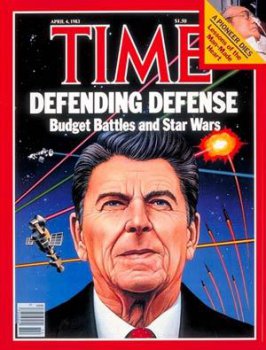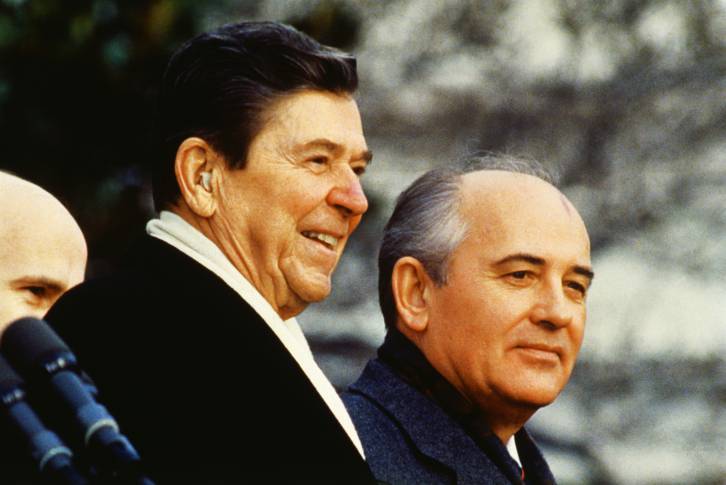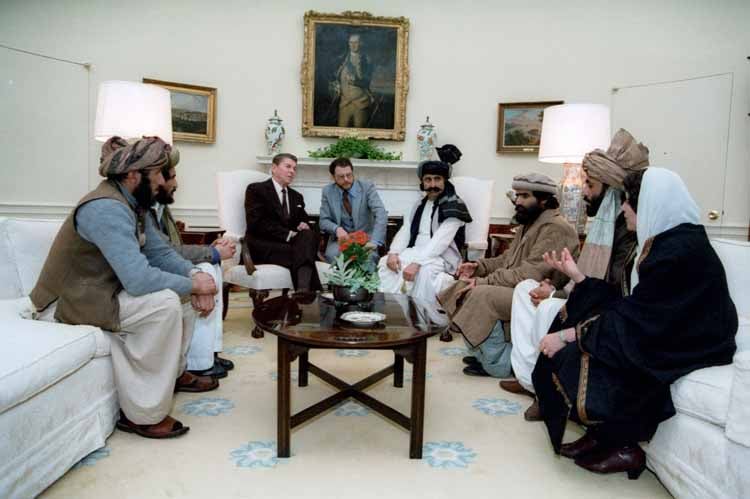
Read Part I:
Master of Fakery: Getting Real About Reagan. “How He Put a Smiley Face on Deception and Extremism”
By Greg Guma, June 10, 2025
***
.
The actual Reagan record included secret wars, scandals, tax cuts for the rich, greater debt, and slashing the social safety net. His functionaries pushed for structural adjustment programs, an international prescription that combined deregulation, privatization, and cuts in social spending. Much of the same was also applied at home.
Even if you remove honesty, popularity and compassion, absent attributes discussed in Part One, didn’t Ronald Reagan end the Cold War? After his death, people like Dick Cheney went as far as to claim his courage and perseverance alone made the difference. But Reagan actually risked nothing, except a record deficit that took a decade to eliminate.
 He had no idea that the Soviet regime would collapse. According to George Kennan, “the suggestion that any United States administration had the power to influence decisively the course of a tremendous domestic political upheaval in another great country on another side of the globe is simply childish.”
He had no idea that the Soviet regime would collapse. According to George Kennan, “the suggestion that any United States administration had the power to influence decisively the course of a tremendous domestic political upheaval in another great country on another side of the globe is simply childish.”
On the contrary, Kennan thought that US militarism strengthened Soviet hard-liners, delaying rather than hastening the change.
Asked whether Reagan’s military spending or “evil empire” rhetoric helped open up the country, Aleksandr Yakovlev, a close advisor to Gorbachev, said “it played no role. None. I can tell you that with the fullest responsibility. Gorbachev and I were ready for changes in our policy regardless of whether the American president was Reagan, or Kennedy, or someone even more liberal.”
 If anyone should get credit for the changes in Eastern Europe and the USSR during the late 1980s, both positive and questionable ones, it’s Gorby and those he set loose. Despite all the tough talk from Reagan and Margaret Thatcher, nothing significant happened until the Soviet Union had a reform leader.
If anyone should get credit for the changes in Eastern Europe and the USSR during the late 1980s, both positive and questionable ones, it’s Gorby and those he set loose. Despite all the tough talk from Reagan and Margaret Thatcher, nothing significant happened until the Soviet Union had a reform leader.
From the start of his political career Reagan was an unapologetic voice for the wealthy, the greedy and the lucky, a corporate spokesmodel who apparently thought Medicare threatened civilization. Many of his disciples agreed. Yet he was called a man of the people. Both the merging of show business and politics that his rise to power represented and the contradictions within his message were anticipated by Hollywood in the late 1950s when a TV star named Lonesome Roads (young Andy Griffith in a wonderful film debut) became an amoral kingmaker in the film A Face in the Crowd. He was Glenn Beck with a guitar and drawl.
What was the real Reagan record? Secret wars, scandals, tax cuts for the rich, greater debt, and slashing the social safety net. Reagan functionaries pushed for structural adjustment programs, an international prescription that combined deregulation, privatization, an emphasis on exports, and cuts in social spending.
Much of the same was also applied at home. By deregulating the savings and loan industry, his regime paved the way for a financial meltdown and bailout that cost taxpayers hundreds of billions. Plus, he set the table for a long-term deregulation push that exacerbated the 2008 economic crisis.
As poverty and homelessness surged, Reagan defended his record with this insight: “One problem that we’ve had, even in the best of times, and that is the people who are sleeping on grates, the homeless who are homeless, you might say, by choice.” Pretty cold.
The hallmark of Reaganomics was tax cuts. In 1981 he spearheaded one of the largest in US history. Heavily weighted toward the wealthy, it widened inequality. As his budget director David Stockman later admitted, the intended effect was to starve the government and justify cuts in spending — except on corporate welfare and the military. Some things haven’t changed. On the other hand, he also supported four tax hikes in his first term and a corporate tax increase in 1986.
Reagan’s team rewrote antitrust laws and oversaw an unprecedented merger binge. The way his chief enforcement official, William Baxter, viewed it, “There is nothing written in the sky that says the world would not be a perfectly satisfactory place if there were only 100 companies.” The nation’s trade gap hit new records, while the environment deteriorated and the EPA budget was cut by half. Countless regulations were discarded or revised based on pseudo-scientific conclusions.
The biggest myth about Reagan may be the claim that he was a reluctant warrior eager to make peace, and not a celluloid cowboy and knee-jerk imperialist who supported dictators and death squads, illegally pursued secret wars, and backed Islamic radicals destined to turn against the US.
Let’s start with General Efrain Rios Montt, who carried out a near holocaust against Indians and peasants in Guatemala. He was condemned around the world. Yet Reagan visited the dictator in 1982, and afterward said he was getting a “bad deal” over human rights abuses. And let’s not neglect Saddam Hussein, whose regime was actively assisted by the US with weapons components, military intelligence, even ingredients for making biological weapons.
In El Salvador, election fraud and the murder of anyone who dissented led to civil war. Reagan responded with unlimited money, military and training that led to torture and para-military death squads. The CIA and other US personnel played active roles. The outcome was at least 75,000 civilian deaths, the thwarting of social change, and more wealth for the oligarchy.
As for secret wars, there’s Nicaragua, under vicious attacks for years by Reagan’s proxy army, the Contras. It was all-out, though largely covert combat directed from DC, and aimed at destroying the government, burning down schools and clinics, mining harbors and dropping bombs. Reagan called his thugs freedom fighters, one of many linguistic subversions. Plus, we had “arms for hostages,” the Secret Team and other off-book covert ops.
Although the idea of backing Islamic fighters in Afghanistan dates from the Carter era — Zbigniew Brzezinski, Carter’s National Security Advisor and initially part of Obama’s brain trust, has taken credit — the government went all-in during the Reagan years. The outcome was more than a million dead, three million disabled, five million refugees, the rise of a medieval regime, and a generation of hostile fundamentalists, originally trained and armed by the US.

Meeting the Mujehadeen (Oval Office)
Is all this ancient history? Not if people continue to accept the fantasy that Reagan was a benign, small government, John Wayne type with compassion and deeply held principles. Not if they believe that those who exploit his fake bio will somehow restore his imaginary legacy. At times like these someone needs to say, “Wake up. You were totally screwed by that guy.”
It also matters because the political establishment and most media have marketed a fake, and may someday do it again. According to Joseph Goebbels, “If you tell a lie big enough and keep repeating it, people will eventually come to believe it. The lie can be maintained only for such time as the State can shield the people from the political, economic and/or military consequences of the lie.”
The shielding was pretty effective until the 2008 financial meltdown, and the deception persists. So, if we don’t want to be roofied again in the future, let’s get clear on what happened in the past. When Reagan was in charge, the government grew — along with the deficit, taxes rose — except on the rich, secret wars raged, corruption reigned, violations of human and civil rights were widespread, and the president was a stone-cold diva who didn’t seem to care. It all sounds chillingly familiar.
This is what Trump and company are bringing back, with rage, resentment, and much more. But as Nancy Reagan used to advise, we can Just Say No. Or if you like, think Gil Scott-Heron: “We don’t need no Re-Ron / We’ve seen all the Re-Rons before.” That one was bad enough.
*
Click the share button below to email/forward this article. Follow us on Instagram and X and subscribe to our Telegram Channel. Feel free to repost Global Research articles with proper attribution.
Greg Guma is a Vermont writer, former editor, and author of 15 books, including Managing Chaos: Adventures in Alternative Media. Visit the author’s blog. He is a regular contributor to Global Research.
Featured image is from the author
Global Research is a reader-funded media. We do not accept any funding from corporations or governments. Help us stay afloat. Click the image below to make a one-time or recurring donation.

Comment on Global Research Articles on our Facebook page
Become a Member of Global Research
Source link

